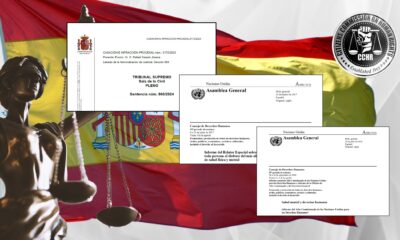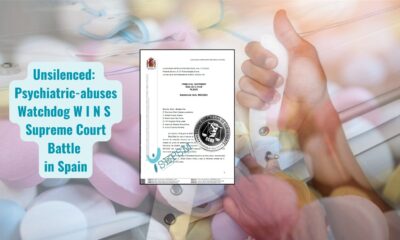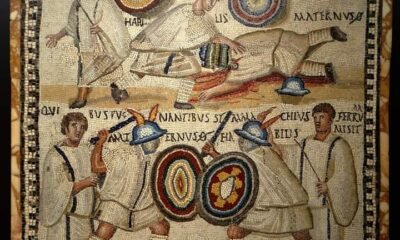Health & Society
The human rights of the “alleged” mentally ill

Is psychiatry really a scientific discipline? And what is a mentally ill person?
A little over thirteen years ago I read on the cover of a health magazine, very critical of the traditional medical system, the headline: Is psychiatry a scientific discipline or a scam? And I have always thought that it would be interesting to capture the spirit of that headline and write a not too extensive book on the subject. Today, as we approach the end of the first quarter of the 21st century, it becomes increasingly urgent to permanently denounce the serious and false pandemic into which these doctors and big pharmaceutical companies are making us fall: mental illness.
Regardless of how history has treated people who have had the misfortune of falling into the hands of an atrociously aggressive psychiatry, with practices such as Lobotomies, Electroshock, chemical experiments, and an atrocious catalog, perfectly documented by historians and doctors in enough sections, we now add how easy it has been for these doctors to instill a false paradigm, where the “alleged mentally ill” It seems that it was born, when the reality is that more and more, different “disorders” are coined in order to pigeonhole the greatest number of people into them, without any scientific basis.
In 2008, in a publication dedicated to health, he prepared a very interesting article-interview, where Juan Pundik, a prestigious psychoanalyst, with more than 40 years of experience, founder and director of the Spanish School of Psychotherapy and Psychoanalysis, and founder-president of FILIUM, Association for the prevention of Child Abuse, among many other activities, highlighted that “millions of children around the world are being unfairly (2008) medicalized to ‘treat’ non-existent ‘behavioral disorders’.
The reference report, extensive and abundant in data, with references to the use of psychotropics already in World War II by the Nazis and the communists of the Soviet Union, as well as many other countries to achieve population control, at any price, throughout recent history, led to a question that I think is relevant to bring up, because, after more than fifteen years, it brings us closer to some of the “concerns of current psychiatrists” without wanting to denounce themselves that those muds and other previous ones, have brought us, almost with total guarantee, the remains of the increase in suicides in modern societies and the continued abuse of the so-called zombie drug: Fentanyl.
-What drugs do you consider are being prescribed excessively and inappropriately?
–As part of this anti-medicalization campaign, in April 2006 I published ‘The Hyperactive Child’, a work in which I denounced the massive prescription of Rubifen, Concerta, Ritalin and methylphenidate to which children are generally being subjected. I denounced the non-existence of ADHD or Attention Deficit Disorder with or without hyperactivity, of the corrupt psychiatric bible that represents the diagnostic and statistical manual of mental disorders -DSM- and of the ‘pediatric cocaine’ of which the drug actually consists. ‘methylphenidate’.
If you are interested you can read everything related to the Rubifen and its main component methylphenidate: TOP ::. RUBIFEN 20 mg TABLETS LEAFLET (aemps.es).
Regarding said DRUGS in capital letters, Juan Pundik himself argued in 2008: Let’s not forget that the Rubifen package insert indicates dry mouth, dizziness, headache, insomnia, nausea, nervousness, palpitations, skin reactions and blood pressure changes as possible side effects. And according to some studies it can cause the sudden death of the child. A paragon of virtues. The same leaflet indicates that it should not be administered to children under 6 years of age and also warns that its use can generate amphetamine-type dependence. Today methylphenidate, a selective inhibitor of the reuptake of dopamine, noradrelin and serotonin, is considered one of the most addictive drugs.

But since this medication is so dangerous, like many others that are on the market today, when secondary symptoms arise, the doctor, in most cases, counterattacks with more medication for the pain or discomfort that has occurred, without take into account the origin. And it is when we reach over-medicalization where we find patients who take an exacerbated amount of medications with no possibility of cure, except for ending up turned into a zombie, where they will end up being blamed by the medical class, being branded as addicted.
And when they give you the label of addicted, It is because in general they have not known how to face or manage doctors’ instructions wisely. And therefore you are a mentally ill definitive, since, like a stigma, you will carry said disease The addiction, throughout your life, with the doctor or psychiatrist being the one who will go on television to clearly say that these people have little capacity to face a reasoned or reasonable solution.
It is at this point that the human rights of these people slip down the toilet without anyone doing anything to review in a real way the gears that move the real industry behind psychiatry.
For those of us who walk on leaden feet treading nauseating puddles like this, sometimes we see that there are too many mental diseases, too many excesses, too many stories that make us fear that something dark and sinister is hidden, at least in some of the historical atrocities of which some psychiatrists have been protagonists throughout history, all of them with names and surnames.
I closed the notebook on November 24, 2023, at 11:03 with the purpose of collecting information for other stories.
As always, search and search for information on the Internet, in books, from people, and when you see that you already take more than a couple of pills a day, look for a trusted doctor who can dedicate a little more than five minutes to you and try to solve your problems. doubt, your life may be in danger. And of course, do not self-medicate or abandon any treatment without a qualified expert, unless it is possible that he or she is not the person who prescribed the medication.
Bibliography:
DSALUD Magazine, no. 128
DSALUD Magazine, no. 104
.:: TOP ::. RUBIFEN 20 mg TABLETS LEAFLET (aemps.es)
Health & Society
Victory in the Supreme Court: CCHR’s criticism of psychiatric abuse not without factual basis
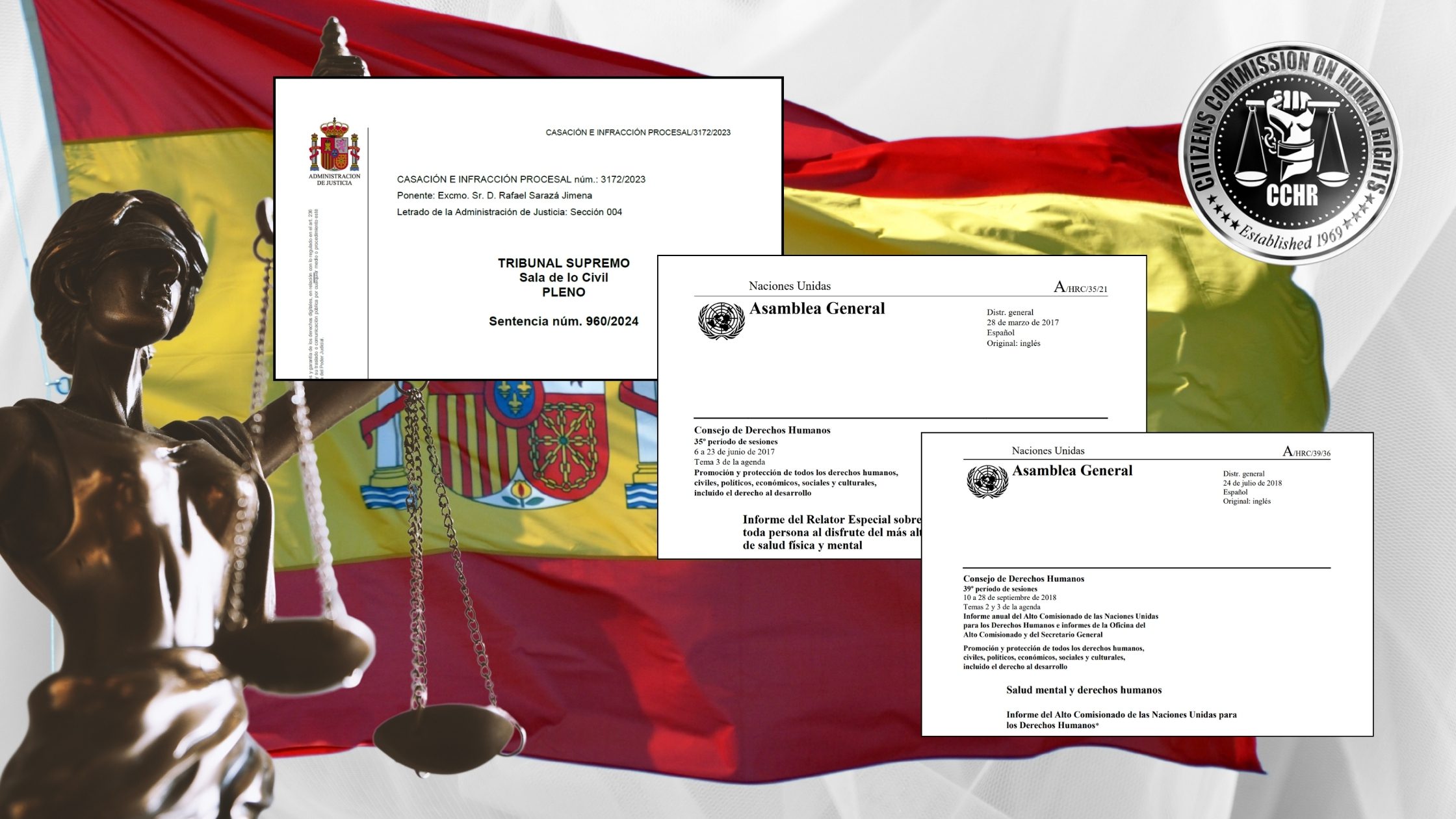
SALUDMENTAL ( Original in Spanish ) The Plenary Session of the Civil Division of the Supreme Court, in its ruling STS 960/2024 of July 9th and published on the 12th in response to the appeal after its defeat in the Provincial Court of the Spanish Society of Psychiatry (SEP), admits that the opinions and harsh criticism that the Citizens’ Commission on Human Rights (CCDH and CCHR) makes of psychiatric abuses such as those made with the use of psychotropic drugs, involuntary institutionalisation, electroshock, psychosurgery and others, “are not devoid of a sufficient factual basis”, and therefore decides to protect the right to express them, even in a harsh manner, as they are of “undoubted general interest”, as transcribed in this extract from the judgment:
“The publications in question deal with a matter of undoubted general interest: the debate on certain practices in the field of psychiatry. The extensive documentation submitted by the defendants clearly shows the existence of this debate. The reports of the UN rapporteurs submitted by the defendants (specifically, the 2017 ‘Report of the Special Rapporteur on the right of everyone to the enjoyment of the highest attainable standard of physical and mental health’ and the 2018 ‘Annual Report of the United Nations High Commissioner for Human Rights’ on ‘Mental Health and Human Rights’) are a good illustration of the important social, political and scientific debate on the issues covered by the questioned publications.
The debate on certain psychiatric practices and, in particular, on involuntary institutionalization, the use of psychotropic drugs, especially when the patients are children or adolescents, or surgical or electroconvulsive treatments, is of particular importance in today’s society.”
Furthermore, the high court affirms, “despite the crudeness of some of its expressions (…), its content is directly connected to the public debate in a democratic society (…) And is part of the conduct observed by CCDH of actively intervening in the social debate on psychiatry through its publications.”
On this basis, the Supreme Court has ruled that the Spanish Society of Psychiatry (SEP) must bear the criticism of the Citizens Commission on Human Rights. (CCHR) and Comisión Ciudadana de Derechos Humanos de España (CCDH).
Salvador Fernández, President of the Spanish Citizens’ Commission on Human Rights, after learning of the sentence declared that:
“it is important that there be protection so that the innumerable abuses that are committed in the field of psychiatry are made known, and the time has come to carry out the drastic reforms called for by the WHO, the UN, and above all the victims, of a century-old system that has brought more pain than glory, we thank all those who work in one way or another to expose and put an end to psychiatric abuse, and from our team we encourage society to not remain silent and to denounce through www.saludmentalyderechos.org any and all abuses in the field of psychiatry, whether it be the labelling and administration of dangerous psychotropic drugs to children, forced treatment, lack of informed consent, involuntary institutionalization or the use of electroshock, which has been described as torture on numerous occasions by doctors and human rights experts.”
CCHR was co-founded in 1969 by the Church of Scientology and Professor Emeritus of Psychiatry Dr. Thomas Szasz as an independent mental health watchdog at a time when patients were institutionalized, mistreated, stripped of their constitutional, civil and human rights, and left to fend for themselves.
As stated by CCHR co-founder Thomas Szasz:
“They were then the only organization, and they still are the only organization, who were active in trying to free mental patients who were incarcerated in mental hospitals with whom there was nothing wrong, who had committed no crimes, who wanted to get out of the hospital. And that to me was a very worthwhile cause; it’s still a very worthwhile cause. We should honor CCHR because it is really the organization that for the first time in human history has organized a politically, socially, internationally significant voice to combat psychiatry. This has never happened in human history before.”
CCHR and national and local affiliates around the world have long fought to restore basic inalienable human rights in the field of mental health, including, among others, full informed consent to the medical legitimacy of psychiatric diagnosis, the risks of psychiatric treatments, the right to all available medical alternatives, and the right to refuse any treatment deemed harmful.
In the judgement of the Provincial Court of Madrid 64/2024 of February 10th, appealed by SEP, the courts explained that CCHR and CCDH:
“aims to fight against abuse in psychiatry and especially against the prescription by these professionals of drugs for the treatment of mental illnesses and diseases and its work has been recognised by the Special Rapporteur of the UN Commission on Human Rights who in 1986 stated that it had helped to pass numerous laws in the field of mental health in defence and preservation of the rights of individuals according to the Universal Declaration of Human Rights, members of the Committee on the Rights of the Child at the United Nations and various members of the US House of Representatives and the California State Congress and Senate.”
In its text, the Supreme Court’s judgement includes, on the one hand, the video documentaries where CCHR shows its evidence and strong statements, opinions and concerns:
“On the other hand, the website www.cchr.org.es, whose content is owned and managed by CCHR (Citizens Commission on Human Rights), provides access to 8 documentaries that explain what they consider ‘psychiatric abuse’.”
And also, the “informative material” found on the website https://www.ccdh.es of the Comisión Ciudadana de Derechos Humanos de España (CCDH) where there are 19 leaflets with very strong titles, such as “Child Drugging. Psychiatry destroying lives. Report and recommendations on fraudulent psychiatric diagnosis and enforced drugging of youth”; “Deadly restraints. Psychiatric ‘therapeutic’ assault. Report and recommendations on the violent and dangerous use of restraints in mental health facilities”; “Brutal Therapies. Harmful Psychiatric ‘Treatments’. Report and recommendations on the destructive practices of electroshock and psychosurgery”; or “Psychiatric Malpractice, the subversion of medicine. Report and recommendations on psychiatry’s destructive impact on health care», among others.
The Spanish Society of Psychiatry complained about demonstrations in which CCDH and others claimed that “psychiatrists are criminals, precursors of genocides, responsible for the erosion of education and justice, inciters of drug addiction, drug traffickers, fraudulent practitioners or managers of violence and terrorism, that some psychiatrists sexually abused their patients and even that ‘[t]here are an undetermined number of coercive abortions in Spain by psychiatrists’, involvement of German psychiatrists in the Nazi holocaust [for which the German Psychiatric Association has publicly apologised], racial discrimination” and other descriptions and statements of fact.
The First Civil Chamber of the Supreme Court concluded that the judgment appealed by SEP had correctly applied the case-law criteria to resolve the conflict between freedom of expression and the right to honour.
And with regard to the context in which the statements in question were made, despite the fact that some of them could be considered serious, says the ruling, CCDH’s conduct in making these publications is part of a public debate of great importance in today’s society, so that agreeing to remove such publications would be an excessive restriction on freedom of expression that would not be justified by an imperative social need.
The SEP also complained about statements, such as that of psychiatrist Dr. Thomas Szasz when he says “Psychiatry is probably the most destructive force that has affected society in the last 60 years’, or ‘Psychiatry serves as a social control machine that sometimes becomes an agent of social and political revenge”, among other imputations.
The SEP argued that freedom of expression should not cover such statements, which the Supreme Court has contradicted, finding that the statements and criticisms of CCDH and CCHR are disseminated in a public debate on psychiatry.
The Supreme Court’s ruling reiterates the importance of freedom of expression in the context of debates of public interest, even when criticism may be offensive to certain entities or professionals, in line with what was said by the court of appeal. And it is here that the Supreme Court states that:
“This prevalence of freedom of expression over the right to honour when expressing opinions on matters of general interest occurs even when the expression of opinion is made in a rude, unkind or hurtful manner and may annoy, disturb or upset the person affected by the statements in question, as this is required by pluralism, tolerance and a spirit of openness, without which there is no democratic society.
As the judgments of the ECHR of 8 November 2016, Magyar Helsinki Bizottság v. Hungary, 13 March 2018, Stern Taulats and Roura Capellera v. Spain, 20 November 2018, Toranzo Gómez v. Spain, and 11 May 2021, Halet v. Luxembourg state, freedom of expression does not only protect ideas that are favourably received or considered inoffensive or indifferent, ‘but also those that offend, shock or disturb’. And Constitutional Court judgment 226/2016, of 22 December, citing previous judgments, states that ‘within the broad framework granted to freedom of expression are protected, according to our doctrine, “those manifestations which, although they affect the honour of others, are revealed as necessary for the presentation of ideas or opinions of public interest”’.
Health & Society
Unsilenced: Psychiatric-abuses Watchdog Wins Supreme Court Battle in Spain
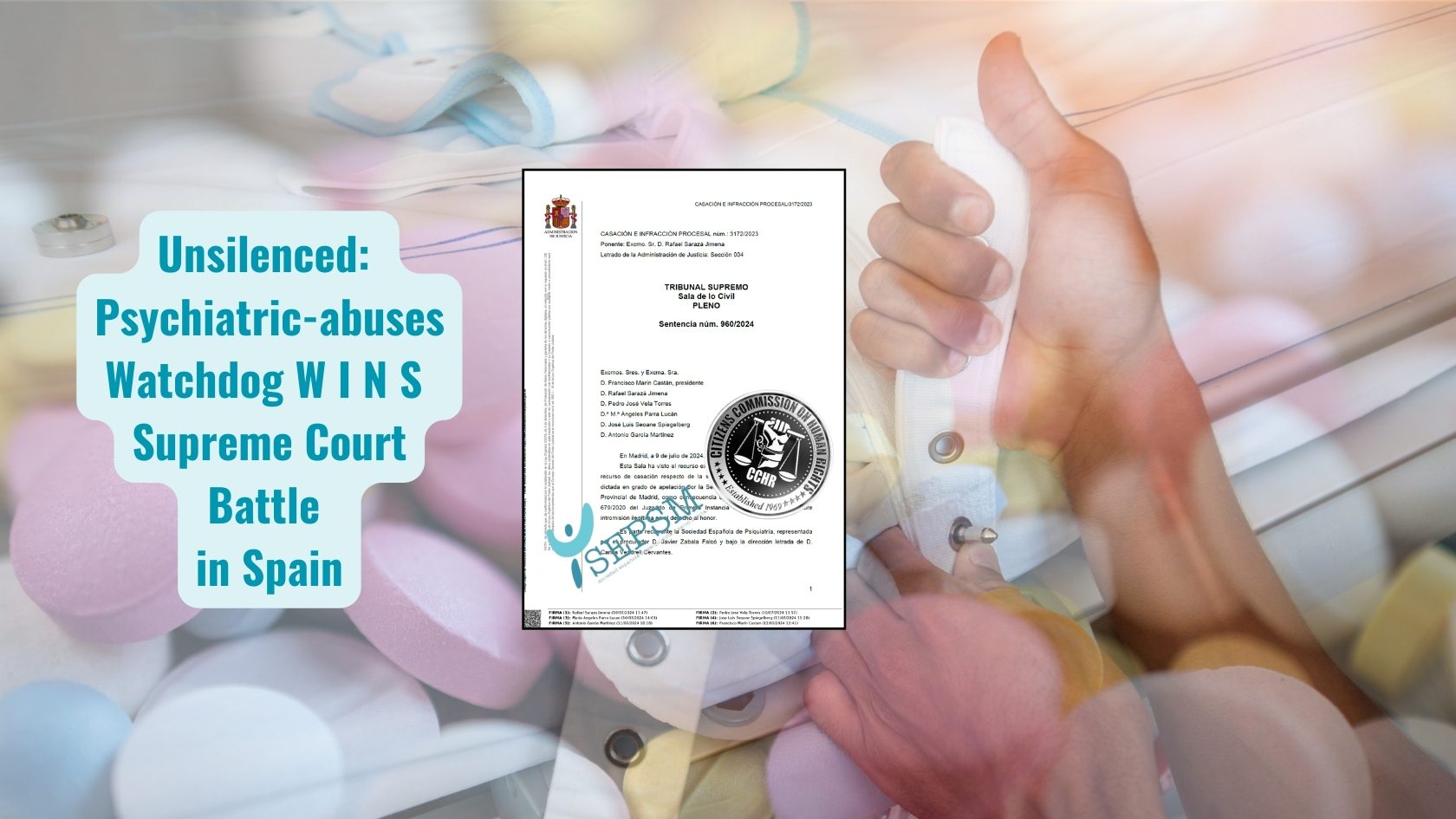
The Supreme Court of Spain asserts in its ruling 960/2024 pf the Plenary of the Civil Chamber, that the public debate in which CCHR International and CCHR Spain are participating are of “undoubted general interest” and therefore It has rejected Spanish Society of Psychiatry (SEP)’s claims to muzzle this mental health watchdog group, stating the Supreme Court that:
The challenged publications deal with a matter of undoubted general interest: the debate on certain practices in the field of psychiatry. The extensive documentation submitted by the defendants clearly shows the existence of this debate. The UN rapporteurs’ reports submitted (specifically, the 2017 “Report of the Special Rapporteur on the right of everyone to the enjoyment of the highest attainable standard of physical and mental health” and the 2018 “Annual Report of the United Nations High Commissioner for Human Rights” on “Mental Health and Human Rights“) are a good illustration of the important existing social, political and scientific debate on the issues that are the subject of the challenged publications. The debate on certain psychiatric practices and, in particular, on involuntary institutionalization, use of psychotropic drugs, especially when the patients are children or adolescents, or surgical or electroconvulsive treatments, is of particular importance in today’s society.
The litigation, which has a long history, stemmed from the SEP’s indignation over CCHR’s websites harshly criticizing abusive psychiatric treatments and practices. The websites of CCHR Spain and CCHR Int in the United States contained strong language against psychiatrists, accusing some of criminal behavior, abuse, and unethical practices. Some headlines in Spanish media like the Medical Journal were Supreme Court finds again in favour of Scientology on its attacks to psychiatrists, Supreme Court dismisses psychiatrists’ ‘defense of honor’ claim, Psychiatric Society’s lawsuit over criticism received from associations dismissed and more.
Accused of being criminals, drug traffickers, genocide preachers, and more
The Spanish Society of Psychiatry and Mental Health (SEPSM / formerly SEP) found another resounding slamming of the door of justice, which has once again ruled in favor of the associations linked to the Church of Scientology and their right to criticize the abuses, thus confirming the judgment of the Provincial Court of Madrid.
The litigation goes back a long way to just before COVID-19 when a series of psychiatrists decided they could not allow any more criticism of the abuses that take place in their ranks, as shown on the websites of the Citizens Commission on Human Rights of Spain (CCDH) and Citizens Commission on Human Rights International (CCHR), harshly attacking the abuses.
The litany of harsh and crude words against psychiatrists cannot be wasted and has been collected in the successive rulings on this case. According to the original complaint from the SEP, on the websites of the associations linked to the Church of Scientology it was stated that:
“psychiatrists are criminals, precursors of genocides, responsible for the erosion of education and justice, inciters of drug addiction, drug traffickers, fraudulent practitioners or managers of violence and terrorism, that there was sexual abuse by some psychiatrists of their patients and even that there was an undetermined number of coercive abortions in Spain at the hands of psychiatrists”.
The ruling in its texts covers on the one side the video materials where CCHR shows their evidences and bold statements, opinions and worries:
On the other hand, from the website www.cchr.org.es, whose content is owned and managed by CCHR (Citizens Commission on Human Rights), you can access 8 documentaries that explain what they consider “psychiatric abuse” and are entitled (I) “Psychiatry, an industry of death“,
(II) “Prescription for violence“, (III) “The age of fear. Psychiatry’s reign of terror“, (IV) “DSM. The Diagnostic and Statistical Manual“, (V) “The Hidden Enemy. Inside the hidden agenda of psychiatry”, (VI) “The marketing of madness. Are we all mad?“, (VII) “Making a Killing. The untold story of psychotropic drugging” and (VIII) “Dead Wrong. How psychiatric drugs can kill your child.”
And also the “informative material” found at the website https://www.ccdh.es) of the Spanish Citizens’ Commission on Human Rights (CCDH) where there are 19 booklets with very hard hitting titles, like for example Drugging Children. Psychiatry destroying lives; Deadly restraints. Psychiatric “therapeutic” assault; The Brutal Reality. Harmful Psychiatric ‘Treatments’. Report and Recommendations on the Destructive Practices of Electroshock and Psychosurgery, and many others that you can read at the end of the article (*).
Despite all the above, and few others documented cases, analysis and opinions, the Spanish Society of Psychiatry did not hesitate to file a lawsuit against the associations so as to shut the capability of documenting and expressing their worries on the abuses, for unlawful interference with the right to honor of its associates for the dissemination through its (CCHR) web pages of the aforementioned statements. However, in this battle between the right to honor and the right to freedom of expression, psychiatrists have lost.
On Friday, the Plenary of the Civil Chamber of the Supreme Court dismissed the claim for protection of the right to honor and considered that the Provincial Court of Madrid had correctly weighed the jurisprudential criteria to resolve the conflict between freedom of expression and the right to honor.
There are also some Psychiatrists who denounce the abuses of their colleagues
The ruling of the Supreme Court stated that:
“The publications on the CCDH website challenged in the complaint express very critical opinions regarding certain psychiatric practices (abuse of drug treatment, especially with children and young people, forced internment, coercive treatment, etc.), which they claim constitute a violation of the human rights of psychiatric patients, and question the scientific basis of psychiatry. They also refer to the existence of sexual abuse by some psychiatrists of their patients and even that “[t]here are an undetermined number of coercive abortions in Spain at the hands of psychiatrists”. – In making such criticisms, they make certainly serious assertions about the professionals who carry out these practices. They do not single out specific individuals or all psychiatric professionals (in fact, some of the opinions expressed in their publications are formulated by psychiatrists).”
It acknowledges that “the publications deal with a matter of undoubted general interest“, such as “certain practices in the field of Psychiatry, and, specifically, on involuntary hospitalizations, use of psychotropic drugs, especially when the patients are children or adolescents, or surgical or electroconvulsive treatments“.
The Plenary ruling admits that the opinions and value judgments for which they are brought to court “are not devoid of a sufficient factual basis”. They consider it “relevant” that such practices “do not refer to specific persons, identifiable with their personal data”. And they state that, “despite the severity of the criticisms and the crudeness of the expressions, its content is directly connected to the public debate in a democratic society and is part of the defendant’s conduct of actively intervening in the social debate on Psychiatry through its publications”.
The ruling also states that:
As the judgments of the ECtHR of November 8, 2016, Magyar Helsinki Bizottság v. Hungary, March 13, 2018, Stern Taulats and Roura Capellera v. Spain, November 20, 2018, Toranzo Gómez v. Spain, and May 11, 2021, Halet v. Luxembourg state, freedom of expression does not only protect ideas favorably received or considered inoffensive or indifferent, “but also those that offend, shock or disturb”. And the judgment of the Constitutional Court 226/2016, of December 22, citing previous judgments, states that “within the broad framework granted to freedom of expression are protected, according to our doctrine, “those manifestations that, although affecting the honor of others, are revealed as necessary for the exposition of ideas or opinions of public interest”.
In accordance with the jurisprudence of the ECHR, which is included in the Supreme Court decision, the questioned statements can only affect the honour or reputation of the members if a certain “threshold of severity” or “level of severity” is exceeded, which in this case “is not reached because, although there is homogeneity in the social group affected by the publications in question (the professionals of Psychiatry), the notes of vulnerability, history of stigmatization or unfavorable social situation do not concur.“
Publications address a debate of “undoubted general interest” the Supreme Court says
In regards to the context in which the questioned statements are made and, although “some could be considered excessive”, the Court recognizes, the conduct of CCDH in making these publications “is part of a public debate of great importance in today’s society”, and so, “agreeing to the elimination of such publications would imply an excessive restriction of freedom of expression that would not be justified by an imperative social need”.
The challenged publications deal with a matter of undoubted general interest: the debate on certain practices in the field of psychiatry. The extensive documentation submitted by the defendants[[Over 15.000 pages reportedly]clearly shows the existence of this debate. The UN rapporteurs’ reports submitted (specifically, the 2017 “Report of the Special Rapporteur on the right of everyone to the enjoyment of the highest attainable standard of physical and mental health” and the 2018 “Annual Report of the United Nations High Commissioner for Human Rights” on “Mental Health and Human Rights”) are a good illustration of the important existing social, political and scientific debate on the issues that are the subject of the challenged publications. The debate on certain psychiatric practices and, in particular, on involuntary institutionalization, use of psychotropic drugs, especially when the patients are children or adolescents, or surgical or electroconvulsive treatments, is of particular importance in today’s society.
David vs Goliath and the objective reality that prevails in the courts
Celso Arango, former President of the Spanish Society of Psychiatry, and one of the main instigators of the attempted muzzling, portrayed themselves as a victorious victim such as David vs Goliath in a letter to their members of February 2022, accessible through a public interview he gave, paraphrasing Samuel 17:49-50:
“And David put his hand in his bag and took out a stone and slung it and struck the Philistine on his forehead. The stone sank into his forehead, and he fell on his face to the ground. So David prevailed over the Philistine with a sling and with a stone, and struck the Philistine and killed him. There was no sword in the hand of David”. […] I [Celso Arango] began this letter with the verse about David and Goliath. It is clear that a modest Society such as ours was facing an economic giant known for its lobbying capacity […] . However, David’s secret weapons were, in this case, a sling called science and a stone called evidence. No matter how much the giant shouts, loud and strong, lies intended to injure our honor and, much worse, to confuse mentally disturbed people as a form of business, objective reality prevails in the courts. As psychiatrists, we should be proud […] of a justice system that guarantees our rights and ensures that Goliath cannot beat David just because he is bigger and has more money.
It seems that Arango would have wanted to turn it into a religious war, feeling as if psychiatrists were the Chosen People of God, and Scientology members (who founded the CCHR to expose abuses in the mental health field) were the philistines, biblically portrayed as opponents of God’s people. Fortunately, it is believed in society that God is not with those who impose psycho-pharmaceuticals, nor with those who impose electroshock, lobotomies, or even with those who involuntarily commit people to psychiatric hospitals, in complete violation of the directives of the WHO and the Office of the High Commissioner for Human Rights.
However, there is one thing that Arango prophesied rightfully in his letter of February 2022: “objective reality prevails in the courts“.
The Supreme Court in its ruling has a) confirmed that psychiatrists have “possibilities of intervening in the public debate and replicating the unfavorable opinions” and b) confirmed and protected CCHR’s right to participate in a public debate of such importance, as it is the respect of dignity and human rights of those who whole visiting psychiatrists to get help, in too many occasions are betrayed either with failing treatments, and more than any acceptable number of times suffer (when they are lucky) abuses and torture, as opposed to the silent death from side effects of barbaric treatments with which some others end.
Titles of some of the publications
1) “Pseudo Science. The false diagnoses of psychiatry. Reports and Recommendations on the Unscientific Fraud Perpetrated by Psychiatry”, 2) “Elder Abuse, Cruel Mental Health Programs. Report and recommendations on psychiatry’s abusive treatment of the elderly”, 3) “Psychiatry’s Manufactured Chaos and Terror. Report and recommendations on psychiatry’s role in international terrorism”, 4) “Drugging Children. Psychiatry destroying lives. Report and recommendations on fraudulent psychiatric diagnosis and forced drugging of youth”, 5) “Psychiatric Rape. Assault on women and children. Report and recommendations on widespread sex crimes against patients within the mental health system”, 6) “Psychiatric Deception, the subversion of medicine. Report and recommendations on psychiatry’s destructive impact on health care”, 7) “Creating Racism. Psychiatry’s Betrayal. Report and recommendations on psychiatry causing racial conflict and genocide”, 8) “Causing Harm to Artists. Psychiatry ruining creativity. Report and recommendations on psychiatry’s assault on the arts”, 9) “Deadly restraints. Psychiatric “therapeutic” assault. Report and recommendations on the violent and dangerous use of restraints in mental health facilities,” 10) “The Real Crisis in Mental Health Today. Report and Recommendations on the Lack of Science and Results within the Mental Health Industry,” 11) “Harming Youth. Psychiatry Destroying Young Minds. Report and recommendations on harmful mental health determinations, evaluations and programs within our schools”, 12) “Eroding Justice, Psychiatry’s Corruption of the Law. Report and Recommendations on Destructive Psychiatric Influence in the Courts and Correctional Services,” 13) “Schizophrenia, Psychiatry’s Disease for Profit. Report and recommendations on psychiatric lies and their diagnoses”, 14) “Psychiatry, trapping your world in drugs. Report and Recommendations on Psychiatry’s Creation of the Current Drug Crisis,” 15) “Rehab Fraud. Psychiatry’s Drug Scam. Report and Recommendations on Methadone and Other Disastrous Psychiatric Drug “Rehab” Programs,” 16) “The Brutal Reality. Harmful Psychiatric ‘Treatments’. Report and Recommendations on the Destructive Practices of Electroshock and Psychosurgery,” 17) “Profane Assault. Psychiatry versus religion. Report and recommendations on psychiatry’s subversion of religious beliefs and practices,” 18) “Mass Fraud. The corrupt psychiatry industry. Report and recommendations on a criminal monopoly on mental health”, and 19) “Community Ruin: Psychiatry’s coercive “care”. Report and recommendations on the failure of community mental health and other coercive psychiatric programs.”
Health & Society
Religious fundamentalism as psychosis
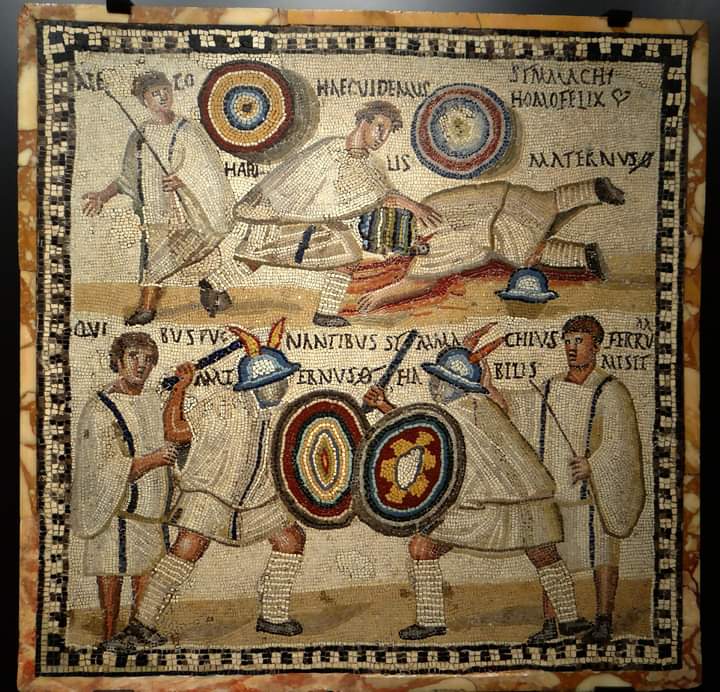
By Vasileios Thermos, Psychiatrist, Professor, and Priest of the Church of Greece
At the very beginning, we consider it necessary to make some clarifications. First of all, fundamentalism is not about specific ideas and beliefs. It should be seen as a particular worldview, as a way of thinking and relating – dualistic, paranoid, despotic and punitive.[1]
From this point of view, fundamentalism, although born in a Christian environment, is also found in a secular context – even an atheist or a rationalist can exhibit the above characteristics in their way of thinking. In such a case, the term “fundamentalist” is not used literally, insofar as it does not refer to the content of specific ideas. It is not related to any relevant reflection on the foundations in the particular variation of Modernity. Rather, it refers to the modern practice of investing in an absolute way in concrete ideas, as well as the neglect and hatred of the different that accompany this practice. Humanity has experienced the horror of secular fundamentalism in the form of militant godlessness. In our time, this hybrid manifests itself in the more moderate forms of ideological bias and scientific fanaticism.
Returning to our topic of religious fundamentalism, we must note that its definition is subject to semantic distinctions based on the various cultural elements that influence and participate in its formation. There is a group of fundamentalist Christians in the US who may not fall under the label of “religious fundamentalism”. This more moderate form of religious fundamentalism that we find there can be explained by the different distribution in the conservative-liberal range. In America, the term “conservative” as a self-definition includes a large number of Christians, the same ones who in Europe place themselves at the center of this scale. Europeans who self-identify as “conservatives” tend to be more austere, i.e. closer to a more extreme fundamentalism. The same is true of Islamic fundamentalism, although in this case research is needed as to what are those special paths that lead to its manifestation. In Europe, Islamic fundamentalism has most likely also adopted local characteristics, as there are many victims of Islamic radicalism.
On the other hand, it is easily explained that a more conventional conservatism, such as the American one, leaves a free field on the right for a tamer fundamentalism. No matter how controversial the latter, there is no doubt that many Americans would feel offended if someone classified them as a fundamentalist in the sense of a state of psychosis.[2]
* * *
Religious fundamentalism arose initially as a reaction of some Protestants against what they themselves saw as a threat from Modernity. Sometimes this threat was limited to their imaginary constructions; other times, however, very often, the threat was real – traditional interpretations of theological truth were threatened (because the encounter with Modernity calls for new interpretations) or truth itself was threatened (although, of course, fundamentalism does not represent an appropriate and productive alternative to rationalism).
The secularization that erupts from Modernity is a systemic expression of the modern subject’s thirst for individual autonomy and independence from any religious framework. Under this prism, secularization is loved and surrounded by trust and faith, it has become a movement and an ideology. In fact, Modernity has radically changed the way we think, as well as the way we think we should think.
As a reaction against this, religious fundamentalism feels that the world that springs from Modernity is hostile, and so fundamentalism encourages us to return to the sources, to the foundations. As a result, it is in fact a product of the stress arising from the consciousness that the modern remarkable cultural turn is irreversible, that both society and science have finally emancipated themselves from the traditional theological foundation. It is obvious that there is no reason to exclude the Orthodox Church from this description, since all societies are westernizing at a very fast pace.
According to religious fundamentalists, history has been distorted by Modernity; what for them is a “fall” is Modernity.[3] Furthermore, fundamentalists proclaim themselves to be the sole judges of truth, the only ones with the authority to decide who follows Christian truth and who is a traitor to it.[4] They have the ambition to unite in their own person and to play all the roles: to legislate, to accuse, to judge and to carry out the punishments at the same time.
An interesting fact that may have escaped public attention is that religious fundamentalism is also a “child” of Modernity. Although an unwanted child, he is nevertheless a true quasi-product of modern times, having developed under their shadow. Paradoxical as this may sound, it can serve to explain many interrelated phenomena.
Recognizing that religious fundamentalism owes its existence to secularization, we understand that both are inseparable entities. Secularization submits to the seductive power of the secular, while fundamentalism fights against it in panic and hatred. Both entities have elevated the mundane to the position of obsession—but each in opposite ways. They resemble each other and are therefore in competition with each other. This is logical, because what is born as a negation or antidote to something else is condemned to see its path determined exclusively by its unwanted “generator”, thus losing the possibility of being an expression of something original. Their constructive polarity explains their kinship, just as rebellious adolescents resemble their despotic parents in the long run.
Paradoxically, although religious fundamentalism is a passionate opponent of psychology, it actually functions as a kind of psychologism. He judges and interprets on the basis of habit, not on the basis of truth. For fundamentalism, what is threatened is immanent identity; it is the decisive criterion by which everything is determined. Terrified by the complexity of the modern world (which has already been modified into the chaos of Postmodernity), fundamentalism is quick to resort to oversimplified solutions because it cannot withstand doubt, confusion and coexistence.
This defensive reaction usually also mobilizes the identification with a characteristic linguistic vocabulary. The struggles of the fundamentalists in the Orthodox Church are well-known for investing in phraseology, in cult, in clothing, statutes and other historical patterns in which later church life has crystallized. Manzaridis writes with alarm that where fundamentalism raises its voice in defense of the sacred and against the profane, it actually absolutizes the created order.[5] In other words, a subconscious “applied psychology” absolutizes concrete human (creature) forms that the truth of the Church has assumed over time in order to articulate the external elements of tradition; therefore, it absolutizes history in its inability to understand that it is thus repeating the same sin against which it so fiercely fights.
Very often the idealization of the created order is characteristic of culture. Florovsky warned us about those who fall into the charm of being fascinated by culture in the name of their faith.[6] Indeed, culture has the remarkable power to attract Christians and get them carried away by it, thereby neglecting the meaning of the Church. Elements that make up this force of culture are customs, aesthetics, and closed community. Customs are capable of denying us our openness to the universality of truth, which is capable of accepting new ways of interpretation. Aesthetics can ensnare the faithful, binding them sensually to what is understood as tradition. And a closed community educates its members to be suspicious of any voice that seems out of place.
A worldview like the one we have described so far cannot function in a healthy way within the fundamentalist community. To be precise, we must say that this community is characterized by a lack of self-criticism, resistance to change, excessive attention to unimportant matters, despotism of leaders and dependence of their followers on them.[7] All these characteristics function as stabilizers of the threatened identity: both individual and collective.
The relationship with psychology is not the only example of that particular psychoanalytic defense mechanism called identification with the attacked. The irony here is that the religious fundamentalists themselves are moving down the same path of heresy, although it usually cannot be understood as heresy in its content, because they have decided to wage war within the Church and in the name of the Church, repeating allegedly and “protecting ” the ancient beliefs. Obviously, this choice of theirs will have to be appreciated and recognized. However, what escapes their notice (because of their outwardly orthodox and spiritual terminology) is that their dominant spiritual needs are exactly the same as those which lead others to resort to a given heresy or sect. As the Russian philosopher Berdyaev warned long ago, “… the fundamentalism of the extreme “Orthodoxy” in religion has a sectarian character. The feeling of satisfaction in belonging to a circle of the elect is a sectarian feeling”.[8]
* * *
However, it is possible to be faithful to one’s religion and be emotionally invested in the foundations of the faith without being a fundamentalist. Healthy religiosity is based on tradition and does not propose to remove its foundations, but at the same time it is incompatible with maladjustment and with prejudice. On the contrary, sick religiosity refers to the profile of a personality that reflects the deformation of the psychic structure: it has Manichean or dualistic beliefs; requires that clear lines be drawn between good and evil; absolutizes the truth and the authoritative figures who proclaim it; experiences anxiety when in complex circumstances; is attracted by the old and the familiar; identifies with maladaptive views; shows an inability to distinguish between essential and non-essential matters; feels uneasy about the changes.[9]
Furthermore, the fundamentalist’s mental image of God is usually that of a cruel and distant God, limited in sensitivity and core to the fundamental defense mechanism. The mechanism of projection is also mobilized to settle the guilt that inevitably arises from self-knowledge. Therefore, blame must be assigned to other individuals or groups. The religious fundamentalist has a desperate need to locate evil in some external source. Unfortunately, it is not uncommon for religious groups to officially show their preference for such processes through their teachings.[10]
Such an unhealthy formed mental structure creates for them a sense of coherence, which culminates in a mental identity, although it is a pressed, superficial and contradictory identity. It also contains some relief from the pressure exerted by the external forces of decay. The cost of these debts is the sharp distinction between those in error and “us of the righteous.”
As if all this was not enough for them, lately the main and defining stress factor for fundamentalists has been getting worse. Postmodernity, characterized by fluid mixing and risky instability, has led to an increase in dissatisfaction. The more prematurely and hastily formed the identity, the more attackable it is now – this is an important point for psychology and for pastoral care. In other words, the problem is perpetuated: the fundamentalist psychosis contains within itself the grounds for its intensification when conditions become less favorable, because it arose as a temporary solution and not as a free mature development.
To the extent that violence usually harbors a barely perceptible threat, it finds its justification in the phenomenon of fundamentalism. Fundamentalists are often insecure in their faith. The reason lies in the fact that their faith, precisely because it is not due to a conscious adoption of dogmas, but to a simple declaration, is not sufficient to tame the external forces of corruption that are innate in each of us. Faith needs a complete existential participation, which implies a living relationship with God; consequently, the lack of emotional sensitivity and responsibility leaves the soul unsatisfied and hanging in the air. Dissatisfaction is thus appeased by the imposition of the dogmas on others; others become a monitor on which the fundamentalists’ unconscious clashes take place.
Consequently, religious fundamentalists are sometimes divided in their desires. In a mental structure that is restless, devoid of peace, as described in the preceding paragraph, the sight of surrounding people who are free and joyful leads to envy, which can quickly escalate into hatred. The sad thing here is that it is disguised as what it considers itself to be “holy jealousy”. The inability to rejoice leads to the prohibition of joy.
Through these processes, fundamentalists base their religiosity on fear rather than love. In this case, offensiveness becomes an actual matter of spiritual survival rather than an expression of courage.[11] As a result, the noblest elements of faith are not internalized, not subjectivized. Instead, deeply uncultivated psychic polemicism finds the possibility of legitimizing itself through the discovery of a strong alibi, such as the defense of “lore,” a defense that derives not from trust but from fear. It is a fear that can develop into real paranoia, i.e. malicious suspicion of non-existent enemies. We understand, then, how the inner-psychic motivations for upholding the tradition are more mundane than fundamentalists can imagine.
What are the spiritual roots of religious fundamentalists’ fear? Psychoanalysis has dealt extensively with introverted (inner) objects as sources of love, hate, and other feelings. The mental image each of us has of God derives its characteristic properties from the internal images of other people we have within us, being guided by our perceived successes or failures of them. When the spiritual image of our parents causes fear in us, then, in the case of the religious person, it is most likely that he perceives God as strict or hostile or persecutory, etc. Some people manage to limit fear in their individual religious field; however, others, depending on the circumstances, legitimize their fear by fitting it into the collective “legitimate” worldview of fundamentalism. By finding one’s place in the collective space, it helps one to legitimize one’s own individual paranoia.
Interestingly, not all fundamentalists preach a fearful and vengeful God; some seem to harbor unhealthy subconscious feelings, while at the same time their sermons are rather theologically sound. This is yet another indication that faith is an existential event, not just some face value of some verbal outpouring.
Based on Melanie Klein’s famous study of the transition from paranoid-schizoid to depressive state,[12] the fear that springs from an internalized “bad god” can coexist with the adoption of a paranoid-schizoid stance along with the inability to develop in direction to a depressed position. What this means, in fact, is that fundamentalists tend to see others as entirely evil, while at the same time seeing themselves as entirely good (as with ideas and interpretations: a sharp distinction between right and wrong dominates). “In psychoanalytic terminology, reductionism means backwardness, erasing the ‘middle ground’, to bisect, dividing the world into security and threat, good and evil, life and death”.[13] Such a thwarting of the normal transition is usually marked by a state of psychosis.
Berdyaev emphasizes that “… the fanatics who act with the greatest empathy, pressure and cruelty always feel themselves surrounded by dangers and always overcome by fear. Fear always makes a person react violently… In the mind of a fanatic, the devil always appears to him as terrible and strong, and he believes in him more strongly than he believes in God… Against the devil’s forces, a holy inquisition or various commissariats are always created… But the devil always he proved to be stronger because he was able to penetrate these institutions and take over their leadership”.[14]
Ignorance of one’s own “I” can reach the point where hatred and fear are repressed, restrained and beautified under the false sense that the persecution is carried out in the name of a hypothetical love. Berdyaev continues with the words: “The holy inquisitors of old were fully convinced that the inhuman acts they did, flogging, burning at the stake, etc., were an expression of their love for humanity… He who sees devilish traps all around him, is the same one who always alone perpetrates persecutions, tortures and guillotines. It is better for a man to suffer short torments within the earthly life than to perish in eternity. Torquemada[15] was an uncomplaining and selfless person, he did not want anything for himself, he was completely dedicated to his idea, to his faith. While torturing people, he served God, did everything exclusively for the glory of God, had a particularly sensitive streak in him, felt no malice and hostility towards anyone, was a kind of “good” person”.[16]
In other words, those who discover devils in harm’s way end up becoming devils themselves, while, in a tragic irony, they care for truth and love!
Dichotomous thinking obviously hinders self-criticism, and to an even greater extent it hinders the building of bridges of communication and exchange with enlightened circles. But the reverse is not inevitable either: not all paranoid-schizoid sufferers develop fundamentalist ideas and practices. It deserves to be investigated why for some people this type of pathology is limited only to individual relationships, while for others it acquires the corresponding views that lead them to form coalitions and struggle to mobilize against the enemy. At the collective level, the inability to reach a depressive position means, in fact, that the group is unable or unwilling to accept the historical trauma and therefore to grieve; instead, it responds to pain with recourse to action and cognitive distortion.
Facts, history and ideas call for interpretation, while time demands that this interpretation be done with urgency. The art of hermeneutics is an opening to the new and the fresh, which call us to make sense of truth amid new conditions. At the same time, every new thing stresses the fundamentalists. They do not wish to interpret because they fear not only mistakes, but – something far more terrible – they fear the appearance of their own otherness as interpretive subjects. Fundamentalists, swayed by the utopian expectation of an imagined totalitarian purity, unable to bear doubt or polyvalence, fearful of what will happen in the wake of the gradual disclosure of their own “I”—let us not forget that interpretation is at the same time a litmus for the truth of the interpreter himself, and not only for the truth of the object—suggests in the end to maintain the infantile position, repeating old recipes of their predecessors, rather than marking their lives with their own personal otherness. As a result of the sincere interpretation, inner freedom, security, conscientiousness, the exploration of the abyss of the psychological inner world of the mind and the heart actually manifests in an unforced way; anything can be stressful.
Likewise, the religious fundamentalist is indecisive, unwilling or unable to interpret the sacred texts because he regards them as fossils without considering them in the context in which they appeared. In its finished form, his word is devoid of metaphoricality, which is a necessary means of interpretation. From a psychoanalytic point of view, the religious fundamentalist (as a collective rather than an individual diagnosis) functions in the Church as a psychosis. A main characteristic of psychosis is that the word is always concrete, without a metaphorical function. Among the aspects of metaphor (μεταφορά) are translation (μετάφραση) and contextual theology. As a result, it makes perfect sense that fundamentalists fight both the translation of liturgical texts into a modern common language (in the case of Greece) and the contextual interpretation of theological tradition.
As a result, held hostage to an extreme “cataphatic” truth that is demarcated with intransigent phraseology, religious fundamentalism is unwilling or even hostile to the possibility of accepting the “shaking” of both theological thought and religious experience, that is, to welcome an “apophatic” perspective. Thus, isolating himself, he must inevitably seek out enemies and apostates. Therefore, the other way in which fundamentalism tends towards a state of psychosis is through paranoia, i.e. fear, which shuts down all dialogue and acceptance.[17]
Paranoia should be understood as closely related to dichotomous thinking.[18] If people are either good or bad, then it is easily understandable that a person would want to be counted among the good. Usually, the fear either does not correspond to the potential threat or is artificially created in relation to a non-existent threat. I have mentioned above that inward enmity assumes a Christian guise, and is brought out when the uncultivated destructive forces of the soul are set in motion against that which is perceived as an enemy. Thus, the threat is understood as something that originates from outside, while in reality it is an overt hostility.[19] Paranoia as narrative and activity is a paradigmatic model for unconscious reverse autobiography.
All this really means that religious fundamentalism is a symptom and at the same time an attempt at self-healing: although it is an example of psychosis in the Church, it manages to organize thought patterns and thoughts in such a way as to limit psychotic stress. Consequently, it functions both as an ecclesiastical disease and also as a defense mechanism that prevents this same disease from becoming an individual diagnosis. In other words, it means moving from the individual level to the group level – the fundamentalists make the Church sick so that they themselves do not fall into psychosis!
It is obvious that such a procedure cannot function. Individual psychosis can be treated with the means of psychiatry, while the collective “psychosis” ends in a deformation of theology. It is expected that the dilemma between personal insanity and the apparently secure system of ideas will always find its solution in favor of the former – personal insanity. Orthodox theology is deformed by fundamentalism – either in its verbal form (through the verbal proclamation of isolation or hatred, or mistrust, or fear, etc.), or through its practical application (through its adherence to a hypothetical “tradition”, through the promotion of clericalism or “old age”, of supporting nationalism or the right, of attributing heretical thoughts to anyone with a different opinion, etc.). By placing psychosis at the service of theology, fundamentalism leads to the thwarting of its liberating and saving mission, while at the same time turning pastoral practice into a danger to the souls of men. It also has the power to make even a moderate and necessarily contextual theology seem like an arbitrary or vainglorious alternative.
Karen Armstrong writes of fundamentalists: “They indulge in confrontation with enemies whose secular policies and beliefs seem hostile to religion itself. Fundamentalists do not see this battle as a conventional political struggle, but experience it as a war of the worlds between the forces of good and evil. They fear annihilation and seek ways to strengthen their beleaguered identity through the selective retrieval of certain teachings and practices from the past. To avoid desecration, they often withdraw from society to create a counterculture. However, fundamentalists are not dreamers floating in the clouds. They have absorbed the pragmatist rationalism of Modernity and, under the guidance of their charismatic leaders, refine these “fundamentals” to create an ideology that gives the believer a blueprint for action. Finally, they strike back, undertaking a reconsecration of an increasingly skeptical world”.[20]
While the sanctification of the world is no doubt a desirable thing, if we look at it in a theological perspective, it cannot be the result of forceful imposition; it can only be accomplished through the personal sanctification of Christians. Christ came to “condemn sin in His flesh” (“condemniti greh vo ploti Svoei”),[21] not “in our flesh”.
Religious fundamentalism cannot be understood simply as a flawed way of thinking. It is a false response through ideological and behavioral conditioning to external emotional problems: a false sense of truth and power begins to become inevitable when stress is experienced as humiliating. Fundamentalists feel they have no control over change, which is true; however, they do not have the consciousness that they never had such control! This is one of the most basic deceptions they live by, which originated in times that were more favorable to the Church – “caesar” being the main common denominator of this false feeling. The extreme party in the Church misinterprets its institutional influence, mistaking it for authority over human souls, i.e. they mistakenly believe that when the current culture and political life is positive towards church people, then they are driven by the same beliefs and moral values .
The issue of incapacity requires a lot of attention. The prominent psychologist of religion Gordon Allport links prejudice to inner feelings of weakness and shame: “Sometimes the source of fear is unknown or forgotten or repressed. Fear may simply be a repressed remnant of internal emotional weaknesses in dealing with the processes of the external world… a generalized sense of inadequacy… However, stress is like hostility in that people tend to feel ashamed of it… Although we partly repress it, at the same time we shift its position so that it sublimates into socially acceptable sources of fear. Some people among us display an almost hysterical fear of “Communists.” It is a socially acceptable phobia. The same men would not be honored if they accepted the true source of much of their stress, which is to be found in their personal inadequacy and in the dread they feel of life”.[22]
This excerpt peels back the veil of fundamentalism, stripping it of its intended ideological character, and exposes the profound mental inadequacy and insecurity of the prejudiced extremist fighter. This deficiency is not necessarily objective: particular people may be genuinely talented. Subjective feeling is what rules here, as fundamentalists are emotionally convinced that they are useful and valuable only through “witch hunts”. The traumatic feeling that springs from the experience that history is running against us, indifferent or offensive to our subjective desires, finds solace in the false sense that the fundamentalist is a gifted, blessed man who contributes decisively to the exposure of heresy and the preservation of truth.
Shifting the battle from the psychological to the ideological field is crucial for fundamentalists, because in this way their mental and spiritual malaise is concealed and rationalized. The result is that belief becomes ideology, and as 20th century history has taught us very well, ideologies function as an effective antidote to stress as well as an excellent disguise for psychopathology. Ideologies have the ability to reduce and systematize the complexity of the world, to bring the warmth of belonging, and to banish the guilt caused by angry outbursts, presenting them as blessings against the “bad.” These mechanisms are a very ancient phenomenon, about which St. Basil the Great wrote: “Some, therefore, understand the supposed defense of Orthodoxy as a weapon in their war against others. And, concealing their personal enmities, they pretend to fight in the name of piety”.[23]
Fortunately, fanaticism does not always breed fundamentalism. However, even though they do not match, they have some common characteristics. “A fanatic is self-centered. The fanatic’s faith, his boundless and selfless devotion to an idea, does not help him to overcome his egocentrism. The fanatic’s asceticism—fanatics are often ascetics—does not defeat his devotion to himself, nor is he turned to the actual givens. The fanatic – whatever orthodoxy he belongs to – identifies with his ideas, identifies the truth with himself. And finally this becomes the only criterion of Orthodoxy”.[24] Perhaps one preventive measure would be to pastorally address fanaticism before it develops into fundamentalism.
Let’s make one last comment (but not the last). To what extent has Orthodox fundamentalism been fueled by expanding conservatism and the centuries-old incorporation of our church? Perhaps some good-natured forms of fear of the world are relapsing into vicious fundamentalism because of the facilities that the church space offers them in this direction? In short: might some common characteristics of the Orthodox Church favor extremes instead of restraining them?
In other words, is fundamentalism a purely personal failure, or is it nursed by immanent disorders in the functioning of the system? Prof. Vassilis Saroglu, enumerating many problematic worldviews and behaviors in Greek Orthodox church life (sectarian tendencies, isolationism, Hellenocentrism, hostility to the West, despotism, judicialism, suspiciousness), asks if there is an umbilical cord that probably connects fundamentalism with Orthodox life as such: “Is fundamentalism foreign, or is it related to Orthodox theology?”.[25]
It is difficult for moderate conservatives to diagnose whether the case in question is valid. Because the repressed manifestations of extreme fundamentalist behavioral responses (paranoia, aggression) are invoked, they are unable to recognize that they too probably suffer from milder forms of the same deviant spectrum. To be precise, they exhibit the same characteristics as the fundamentalists, differing from them only in degree and intensity. Their sincere protest “we are conservatives, not extremists”, while formally correct, obscures reality, neutralizes vigilance and leaves unprotected the field in which fundamentalism rises.
If our church wishes to truly weaken and disarm Orthodox fundamentalism, it will need to re-educate its ecclesial totality so that both the psychological and ideological fundamentalist complex is tracked down and obliterated. We know that things do not change quickly, but a clear strategy that is flexible, open to serious and theologically grounded changes, with a vision that is broader than the national, will certainly bear fruit. The key word here is prudence.
This progressive advance means that Orthodox church life (worship, catechesis, leadership, administration) will cease to serve defensive identities, but will instead embrace the very essence of the Incarnation. Indeed, I can find no better description of the antidote to religious fundamentalism than that offered by the late eminent Greek theologian Panagiotis Nelas: “Orthodoxy, which neither fights nor competes with any culture, wants to live in ours as well ( western culture), even more willing to incarnate in it, precisely to help it overcome its immanent impasses. And it can do so, since it is based on the fundamental principle of the incarnation and the transfiguration of the problem, on which the fathers of the Church relied in order to meet the Greek culture. This principle expresses at the level of Church-sacred relations the central Chalcedonian Christological dogma… It is a question of a complete loving surrender, of the pouring out or condescension of the Church towards culture, something that means not only toleration of the elements subject to transformation of culture, but also their complete assimilation in so far as it leads to their transformation into the flesh of the Church… These particular elements of culture must be Christianized. This is where the great reality of asceticism intervenes… The Church is the real and actual Body of Christ, and the body of the Church is pure and simple the social body. Christianity is asceticism, when it does not deny, but accepts the body, loves it and fights to save it”.[26]
We are called to live this change, which is a criterion of vital importance.
* First[ublication:ΘερμόςΒΠληγὲςἀπὸmeaningΚατοἀπὸτὶςἔννοιεςἀνασαίνειἡζωήἈθήνα:“Ἐνπλῷ”2023σ107-133[ublication:ΘερμόςΒΠληγὲςἀπὸmeaningΚατοἀπὸτὶςἔννοιεςἀνασαίνειἡζωήἈθήνα:“Ἐνπλῷ”2023σ107-133
[1] Eklof, T. Fundamentalism as Disorder. A case for Listing it in the APA’s DSM, 2016. The author also highlights the similarity between fundamentalist thinking and the childish way of thinking as described by Piaget: finite and unconditioned, unable to put oneself in the place of the other. This infantility may account for the oversimplification (which represents yet another stressor that creates fear) that anything that cannot be interpreted by the tools available is a threat.
[2] Indeed, I personally know many religious Americans who share an ultra-simplistic religious mindset without necessarily embracing paranoid, despotic, or punitive worldviews.
[3] Hunter, J.D. “Fundamentalism in Its Global Contours” – In: The Fundamentalist Phenomenon: A View from Within; A Response from Without, ed. by N. Cohen, ‘Eerdmans’ 1990, p. 59.
[4] Arbuckle, G. Refounding the Church: Dissent for Leadership, Maryknoll, N.Y.: “Orbis Books” 1993, p. 53.
[5] Μαντζαρίδης, Γ. “Ἡ ὑπέρβασι τοῦ φονταμενταλισμοῦ” – Σύναξη, 56, 1995, σ. 70.
[6] Florovsky, G. Christianity and Culture, Northland, 1974, p. 21-27.
[7] Xavier, N. S. The Two Faces of Religion: A Psychiatrist’s View, New Orleans, La.: “Portals Pr” 1987, p. 44.
[8] Berdyaev, N. “Concerning Fanaticism, Orthodoxy and Truth”, transl. by Fr. S. Janos, 1937 – here.
[9] Jaspard, J.-M. “Signification Psychologique d’Une Lecture “Fondamentaliste” de la Bible” – In: Revue Théologique de Louvain, 37, 2, 2006, p. 204-205.
[10] Jones, J. W. “Why Does Religion Turn Violent? A Psychoanalytic Exploration of Religious Terrorism” – In: The Psychoanalytic Review, 93, 2, 2006, p. 181, 186.
[11] Hunter, J.D. Op. cit., p. 70.
[12] Klein, M. Envy and Gratitude: A Study of Unconscious Sources, London: Basic Books 1957, p. 22-31. Klein deals with the two unconscious positions which mark the organization of the personality at an early stage of life. The schizoid-paranoid position recreates the immature state in which the young child perceives the outside world as “black and white”, i.e. he experiences his mother exclusively as good or as bad, as well as the mother-toddler pair as absolutely good, and the outside world as a potential hazard. The depressive position, on the other hand, is the natural successor of the schizoid-paranoid: with this transition, the individual’s ability to worry is gradually gained, complex perceptions of himself and others begin to form, and the capacity to feel guilt is internalized in adulthood .
[13] Young, R. “Psychoanalysis, Terrorism, and Fundamentalism” – In: Psychodynamic Practice, 9, 3, 2003, p. 307-324.
[14] Berdyaev, N. Op. cit.
[15] Thomas de Torquemada (1420-1498) – Spanish clergyman, first inquisitor of the Spanish Inquisition (note trans.).
[16] Berdyaev, N. Op. cit.; cf. Verdluis, A. The New Inquisitions: Heretic Hunting and the Intellectual Origins of Modern Totalitarianism, Oxford: Oxford University Press 2006, p. 138-139.
[17] Powell, J., Gladson, J., Mayer, R. “Psychotherapy with the Fundamentalist Client” – In: Journal of Psychology and Theology, 19, 4, 1991, p. 348.
[18] Eklof, T. Op. cit.
[19] Arbuckle, G. Op. cit., p. 53; Hunter, J.D. Op. cit., p. 64.
[20] Armstrong, K. The Battle for God: Fundamentalism in Judaism, Christianity and Islam, London: Random House 2000, p. hi.
[21] St. Liturgy of St. Basil the Great – Prayer of Ascension.
[22] Allport, G. W. The Nature of Prejudice, Doubleday 1958, p. 346.
[23] Ἐπιστολὴ 92: Πρὸς Ἰταλοὺς καὶ Γάλλους, 2 – PG 32, 480C.
[24] Berdyaev, N. Op. cit.
[25] Σαρόγλου, Β. “Ὀρθόδοξη Θεολογία καὶ φονταμενταλισμός: ἀντίπαλοι ἢ ὁμόαιμοι;” – Νέα Εὐθύνη, 15, 2013, σ. 93 (the whole article – here).
[26] Νέλλας, Π. “Ἡ παιδεία καὶ οἱ Ἕλληνες” – Σύναξη, 21, 1987, σ. 18-19.
-

 Politics3 days ago
Politics3 days agoPoland’s Former Prime Minister Mateusz Morawiecki Eyes Leadership of European Conservatives and Reformists
-
Travel4 days ago
New Brussels to Venice night train: The 9 cities en route, what it will cost and how to book
-

 EU & the World3 days ago
EU & the World3 days agoDoes Travis Kelce Appear in Swift’s ‘I Can Do It With a Broken Heart’ Music Video?
-

 Health & Society3 days ago
Health & Society3 days agoPope Francis calls on religions to unite to reduce demand for drugs
-
EU & the World3 days ago
Mike Lynch Yacht Update: Fifth Body Recovered Off Coast of Sicily
-

 EU & the World3 days ago
EU & the World3 days agoAshanti & Nelly Welcome First Child Together & Reveal Baby Boy’s Name
-
Travel5 days ago
Southern European tourists flock to Denmark to escape the heat
-

 Sports3 days ago
Sports3 days agoTurin, Urbano Cairo retorts to fans on Bellanova



